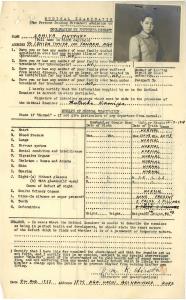From the end of the Second World War to 1965, over 650 Japanese women migrated to Australia as the wives and fiancees of Australian servicemen. Their story is one of courage and strength.
Japanese war brides gave up the familiarity of home and family to journey across the sea and begin a new life in Australia. The records left behind in the National Archives tell stories of the love, adventure, challenges and heartbreak these women faced in the era of the White Australia policy.
Forbidden relationships
After the atomic bombings of Nagasaki and Hiroshima in 1945, postwar Japan was stricken by poverty and devastation.
In 1946 Australia joined the British Commonwealth Occupation Force and stationed troops in Japan for over 10 years.
Australian attitudes towards the Japanese were tense and hostile, and occupation authorities forbid servicemen from fraternising with the locals. Australian servicemen were not allowed to visit Japanese homes or take part in family life.
Despite this policy, Australian servicemen found ways to interact with Japanese people through employment, the black market, entertainment and sightseeing. Many of these interactions led to romantic relationships.
Government attitudes
The Australian Government’s attitude meant servicemen were banned from marrying Japanese women.
However, the marriage ban did not prevent Australian soldiers from applying to Australian authorities for permission to marry in Japan. Even without permission, servicemen married their Japanese wives through the Japanese Christian Church, Japanese registration office, British Consular Office or through traditional Japanese marriage ceremonies.
However, Japanese women continued to be banned from Australia, even when they were the wives or fiancés of Australian servicemen. When their husbands were ordered back to Australia, many women were left behind in Japan, often with young children.
Approved entry to Australia
In 1952, the Menzies government finally granted permission for Japanese wives and fiancés of Australian servicemen to enter Australia.
The application process was lengthy, and there were many factors that could prevent a wife from coming to Australia. One of the greatest obstacles was the health checks. Any Japanese woman who was diagnosed with tuberculosis was immediately denied entry. At one point, prospective Japanese wives were required to submit to medical examination, which included a chest radiograph.
By 1956, the occupation of Japan had ended and Japanese wives were allowed to become permanent Australian citizens.
Mutsuko Reddy (nee Kamiya) is just one of the Japanese war brides who forged a new life in Australia. After marrying Australian serviceman Stephen Reddy in Kobe, Japan, on 3 September 1952, Mutsuko’s immigration application was approved and she arrived in Australia on 6 April 1953.
Fortunately for Mutsuko, she was already able to speak sufficient English and gained work in Queensland as a factory hand. In 1958 she was naturalised as an Australian citizen.
Although often overlooked, the Japanese war brides paved the initial steps towards ending the White Australia policy and left a lasting impact on the future of Australia. Their arrival was at a time when immigration was seen as the key to Australia’s growth and progress. The Japanese war brides challenged Australian attitudes in the wake of the war, and prompted new ideas as to what it meant to be Australian.












